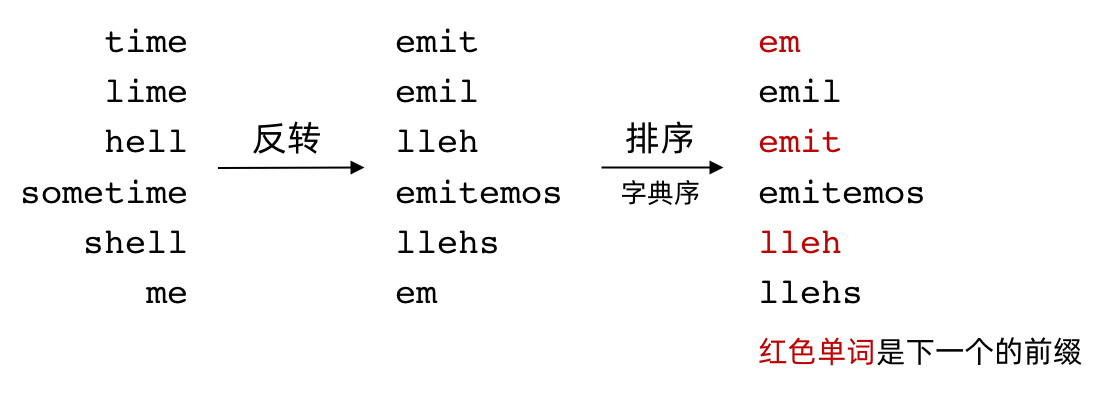Question
A valid encoding of an array of words is any reference string s and array of indices indices such that:
words.length == indices.length- The reference string
s ends with the '#' character.
- For each index
indices[i], the substring of s starting from indices[i] and up to (but not including) the next '#' character is equal to words[i].
Given an array of words, return the length of the shortest reference string s possible of any valid encoding of words.
Solution 1
LeetCode这几天的每日一题时不让我学会字典树势不罢休啊……
字典树,参数isLeaf记录每个TireNode节点是否为叶子节点。
将单词倒序组建字典树,并维护isLeaf的属性。
计算从根节点到达每个叶子节点的长度再加一的和即可。
Code
1
2
3
4
5
6
7
8
9
10
11
12
13
14
15
16
17
18
19
20
21
22
23
24
25
26
27
28
29
30
31
32
33
34
35
36
37
38
39
40
41
42
43
| class Solution {
class TrieNode{
TrieNode[] next = new TrieNode[26];
boolean isLeaf;
}
TrieNode root;
int count;
public int minimumLengthEncoding(String[] words) {
count = 0;
root = new TrieNode();
for(String word : words){
add(word);
}
countLeaves(root, 0);
return count;
}
private void add(String word){
TrieNode curr = root;
for(int i = word.length()-1; i >= 0; i--){
int index = word.charAt(i) - 'a';
if(curr.next[index] == null){
curr.isLeaf = false;
curr.next[index] = new TrieNode();
curr.next[index].isLeaf = true;
}
curr = curr.next[index];
}
}
private void countLeaves(TrieNode root, int length){
if(root.isLeaf){
count += length + 1;
}
else{
for(int i = 0; i < 26; i++){
if(root.next[i] != null) countLeaves(root.next[i], length+1);
}
}
}
}
|
Solution 2
排序,将数组words根据单词倒序排序。
倒序构成字典树,如果展开新的字典树分支(创建新的TrieNode节点)则将count加入根节点到新节点的距离。
Code
1
2
3
4
5
6
7
8
9
10
11
12
13
14
15
16
17
18
19
20
21
22
23
24
25
26
27
28
29
30
31
32
33
34
35
36
37
38
39
40
41
42
43
44
45
46
47
48
49
50
51
52
53
| class Solution {
class TrieNode{
TrieNode[] next = new TrieNode[26];
boolean end;
}
TrieNode root;
int count;
public int minimumLengthEncoding(String[] words) {
Arrays.sort(words, new Comparator<String>(){
public int compare(String a, String b){
int i = a.length()-1, j = b.length()-1;
while(i >= 0 && j >= 0){
int index = a.charAt(i) - b.charAt(j);
if(index == 0){
i--;
j--;
}
else{
return index;
}
}
return j - i;
}
});
count = 0;
root = new TrieNode();
for(String word : words){
add(word);
}
return count;
}
private void add(String word){
TrieNode curr = root;
int length = 1;
boolean newTrieNode = false;
for(int i = word.length()-1; i >= 0; i--){
int index = word.charAt(i) - 'a';
if(curr.next[index] == null){
curr.next[index] = new TrieNode();
newTrieNode = true;
}
curr = curr.next[index];
length++;
}
curr.end = true;
if(newTrieNode) count += length;
}
}
|
Solution 3
倒序重组字符串并记录到reversedWords[]数组,然后根据字典顺序排序。
如果数组的上一个字符串不是下一个字符串的前缀,则加入上一个字符串的长度加一。

Code
1
2
3
4
5
6
7
8
9
10
11
12
13
14
15
16
17
| class Solution {
public int minimumLengthEncoding(String[] words) {
String[] reversedWords = new String[words.length];
int count = 0, index = 0;
for(String word : words){
reversedWords[index] = new StringBuffer(word).reverse().toString();
index++;
}
Arrays.sort(reversedWords);
for(int i = 0; i < words.length-1; i++){
if(!reversedWords[i+1].startsWith(reversedWords[i])) count += reversedWords[i].length()+1;
}
count += reversedWords[words.length-1].length()+1;
return count;
}
}
|

